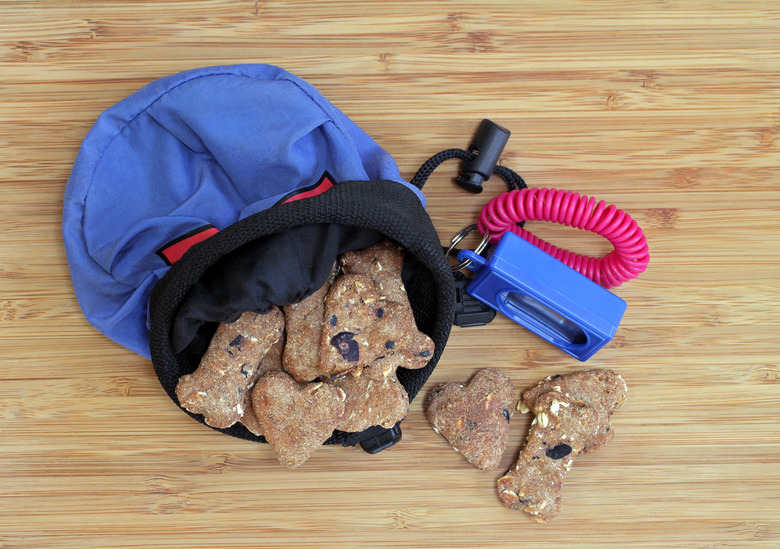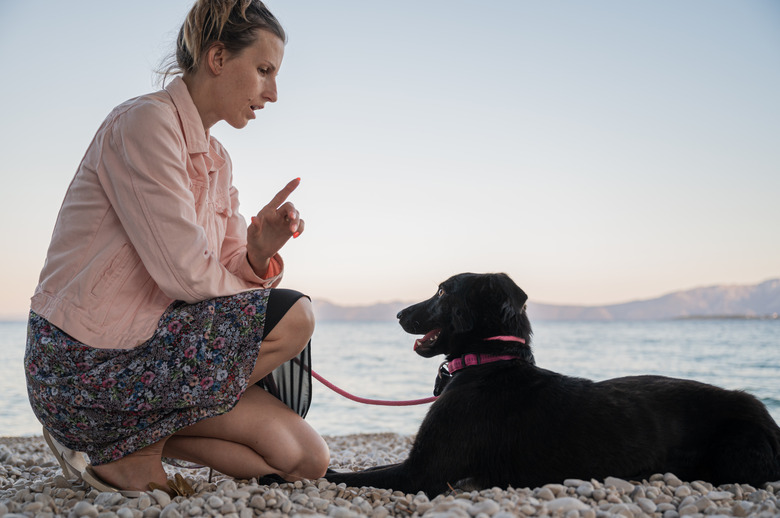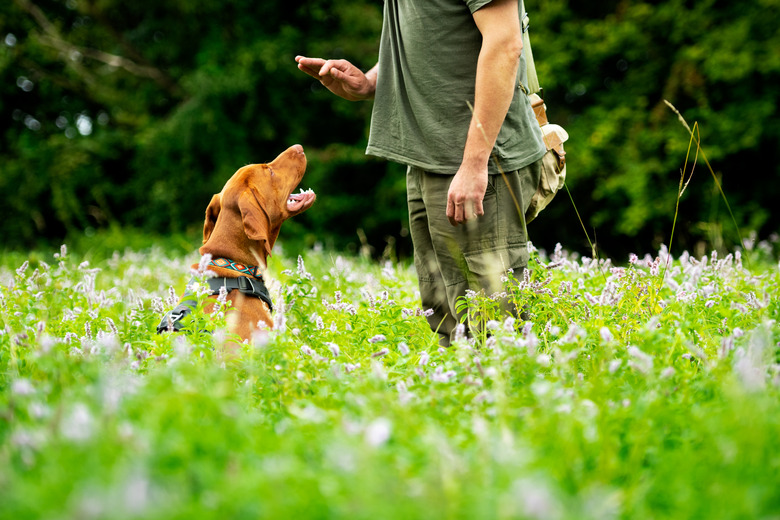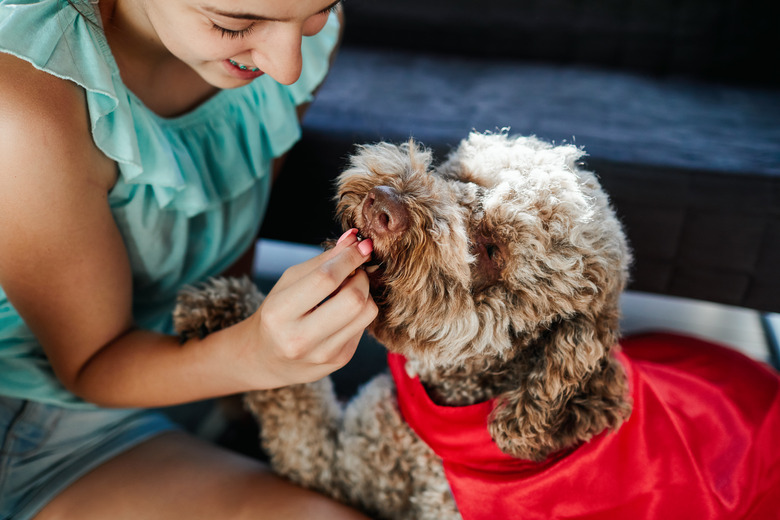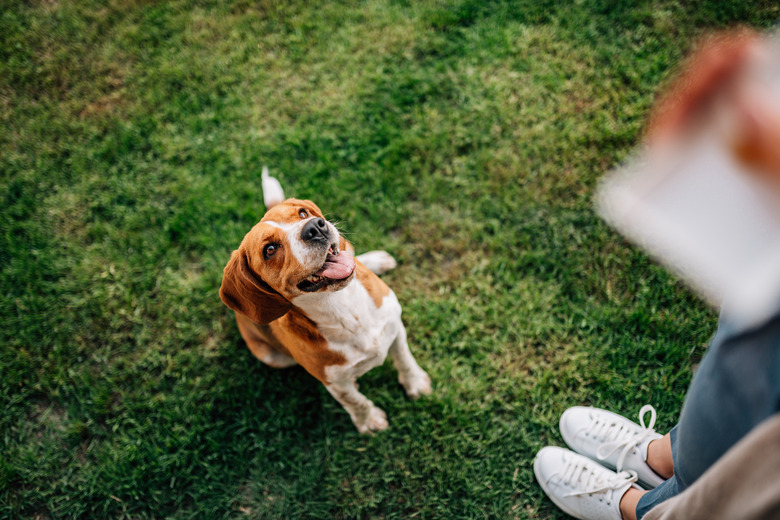What Is Positive Reinforcement Training?
For years, many people believed that training their dogs required them to assume "alpha" status to get their canine friend to behave desirably, often through punishment. More recently, however, more people are looking toward positive reinforcement training, which encourages good habits without punishing the bad ones. A 2016 paper cited several studies comparing positive reinforcement training methods to other techniques, like negative reinforcement, all of which saw a decrease in fear and aggression when the former was implemented. So, it seems that the research indicates that it's the way to go, but what exactly is positive reward training, and how can you use it with your dog?
Why use positive reinforcement training?
Why use positive reinforcement training?
According to the American Kennel Club, positive reward training techniques work because behaviors that are rewarded with something pleasant are more likely to become habits. "Positive reinforcement actually can decrease bad behavior by replacing it with good behavior," explains Cassie Pestana, KPA-CTP, CPDT-KA. Unlike punishment, which can lead a dog to become fearful and distrustful, positive reinforcement utilizes a dog's natural ability to learn through association. Positive reinforcement does not correct unwanted behavior. Instead, positive reinforcement training is intended to increase the frequency of good behavior by allowing a dog to associate a reward, like a tasty snack, with exhibiting a good behavior, like ignoring a passing dog on the sidewalk.
How to use positive reinforcement training
How to use positive reinforcement training
Positive reinforcement training requires only a few things: a cue or other such sound, a high value reward (like an extra tasty treat or a highly prized toy), and patience. A food-motivated dog will make things that much easier, but isn't entirely required in order to see effective results.
To use positive reinforcement training, start by identifying what it is you wish to see more of from your dog. For many people, this includes having your dog focus on you, rather than what's around her, on walks. Every time your dog looks at you, she gets a reward. People often use an audible marker, like praise or a click (if you opt for clicker training) the moment the correct behavior is displayed, which is then immediately followed by a reward. This routine is done over and over until it becomes a habit for your dog.
If you're interested in taking a positive reinforcement training approach with your canine, it's suggested that you reach out to a reputable trainer in your area to get you started. (The AKC has a helpful guide on how to choose a dog trainer.)
What is not positive reinforcement?
What is not positive reinforcement?
Not punishing your dog when she displays what's deemed as "bad" behavior is a great practice to keep, but simply doing that is not exactly what positive reinforcement training is all about. If you've previously used less-than-positive methods to train your dog, even if that's just yelling when she does what you don't want her to, and you simply stop doing, that you may be creating a more pleasant experience for your dog, but you still aren't helping her recognize what you want from her.
Positive reinforcement training relies on an added stimulus, like a treat or a toy, to reward the dog on a job well done, which will help them seek that reward by exhibiting good behavior over time.
Additionally, positive reinforcement is not positive punishment. Positive punishment is used to decrease an unwanted behavior by adding a negative element, like leash correcting or using a prong collar. Another type of operant conditioning is called negative punishment, which sounds more harsh than it is — this can consist of refusing to walk until your dog stops pulling on her leash. Although the good behavior is technically rewarded once the bad behavior stops, it still doesn't teach dogs to associate positive experiences with preferred behavior. Positive reinforcement is used to increase good behavior.
What if my dog is not food motivated?
What if my dog is not food motivated?
While positive reinforcement training is made easier for the trainer when the dog being trained is motivated by the food, being offered that doesn't necessarily mean that your dog must jump for snacks in order to learn through positive associations. All dogs, like people, experience joy over something, so a pet guardian with a dog who isn't particularly excited by food treats will just need to identify what it is that makes their dog feel great. Often, praise or a favorite toy work as great substitutes for food, assuming your dog loves either of those things. Additionally, dogs who don't seem to be food motivated might not be taking food for a reason, like fullness, distasted for that particular snack, and anxiety. If the latter of which is the case for your dog, it is recommended that you move your training session to a less overwhelming space, and never try to force a food reward onto your dog.
Before you move on to other rewards, try increasing the value of the rewards with food your dog doesn't usually get to enjoy, like meat or cheese, which may appeal to him better than snacks created for dogs. If your dog is on a special diet, talk to your veterinarian about possible snack choices, which may include the main ingredient of the food your dog is eating.
Finally, some trainers may recommend using your dog's meals as the reward, offering small bits at a time while you are working with him during training sessions. It is important to recognize if your dog is being underfed in the name of training, which should never be the case — be sure to feed your dog his recommended amount of food, but you can try timing the delivery around training sessions.
Clicker training
Clicker training
One of the most popular methods of positive reinforcement training is clicker training. Clicker training is a reward-based training technique which uses a clicker tool that makes a sound to mark the moment when a dog exhibits a desirable behavior. Once the behavior is noted and the clicker pushed, the trainer then gives their dog a reward, thereby creating a positive association with the sound and behavior. Clickers are generally effective, although some anxious dogs may not prefer the sound of the click, so be sure to observe how your dog is responding and continue only if it doesn't seem to be causing stress.
What if I feel that positive reinforcement training isn't working?
What if I feel that positive reinforcement training isn't working?
If you've tried positive reinforcement training and you feel that it either isn't working, or you and your canine friend have plateaued in your progress, there are some things you can try to get things on track.
First, make sure the reward you're using is worth working for. If you're using food but it doesn't seem to be gauging much interest, you may need to up the ante to something really high value — small bits of deli slices, meatballs, and bits of cheese are popular rewards for food motivated dogs!
If you're not using a clicker or marker word such as "yes," try adding one. Be sure that your dog's only form of exercise isn't coming from training, as often, dogs with energy to burn cannot and will not focus on their training sessions.
Finally, if you feel like you have tried everything and are still not noticing progress, reach out to a qualified trainer (who only uses positive reinforcement techniques) in your area who will be able to help you in your training journey.
References
- Preventative Vet: Dog Training Aversives: What are they and why you should avoid them
- AKC: Mark & Reward: Using Clicker Training to Communicate with Your Dog
- Companion Animal Psychology: What is Positive Reinforcement Training?
- Journal of Veterinary Behavior: The effects of using aversive training methods in dogs
- K9 Aggression: Dog training tip: training a dog who isn't food motivated
